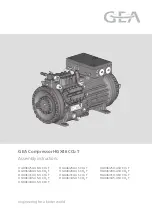
FORM 220.11-NM2 (602)
11
YORK INTERNATIONAL
SECTION 2
INSTALLATION
GENERAL
Foundation
These compressors can be furnished with a fabricated
steel base for installation on a suitable foundation of
sufficient strength and rigidity to support the weight of
the operating system. Refer to Figure 2 and Table 3 for
housing and component weights.
Installation Information
Since the equipment will vary to meet the requirements
of a specific installation, it is recommended that the fol-
lowing information be retained for ready reference.
These are furnished with each compressor at the time
of original purchase:
1. A general arrangement drawing.
2. A sectional assembly drawing.
3. A lubrication system schematic diagram.
4. An oil piping drawing.
5. A coupling instruction.
6. An application data sheet.
CONDUCTING THE PRESSURE AND VACUUM / DE-
HYDRATION TESTS
If a pressure test is required perform the following:
Perform all pressure testing and
evacuations before applying insula-
tion of any kind to the system.
Charging of refrigerant should only
occur after completion of the evacua-
tion/dehydration procedure. The re-
frigerant charge should be introduced
into the system as outlined in the ap-
plicable instructions for the job. Cer-
tain conditions can result in very low
temperatures which can be damaging
to equipment/personnel.
1. Conduct the pressure test in accordance with de-
sign parameters outlined in the application data
sheet.
The compressor’s atmospheric shaft
seal may leak excessively if the shaft
seal reservoir has not been filled with
oil.
2. If the atmospheric shaft seal is leaking, charge the com-
pressor shaft seal reservoir with the appropriate YORK
oil (refer to Adding Oil to the Compressor, pages 27
and 28) before continuing the pressure testing.
3. After completion of the pressure testing proceed
with the evacuation/dehydration of the system.
4. Conduct the vacuum test in accordance with the
procedures outlined in Form 55.60-NM12.
INITIAL STARTING – MECHANICAL RUN-IN
Perform the following “bump-in” procedures when
starting any compressor for the first time or after re-
placing bearings and seals.
Seals may settle and contact the shafts
during shipment. A “bump-in” is rec-
ommended to position the floating
seals in their preferred operating lo-
cation. Compressors designed for ha-
locarbon refrigerants or air service can
be mechanically run-in without ex-
ceeding the discharge temperature
limit. The application data sheet will
set the discharge temperature limit
and indicate if a mechanical run-in
cannot be performed.
“Bump-in” Procedure for Turbine and Motor
Driven Systems
Shut down the compressor immedi-
ately if any abnormal conditions are
detected.
2
Summary of Contents for Turbomaster M Series
Page 15: ...FORM 220 11 NM2 602 15 YORK INTERNATIONAL FIG 3 TYPICAL PRIMARY COMPRESSOR GAS FLOW LD07318 3 ...
Page 16: ...YORK INTERNATIONAL 16 FORM 220 11 NM2 602 FIG 4A MAJOR COMPONENTS LD07319 Operation ...
Page 31: ...FORM 220 11 NM2 602 31 YORK INTERNATIONAL Operation 3 This page intentionally left blank ...












































